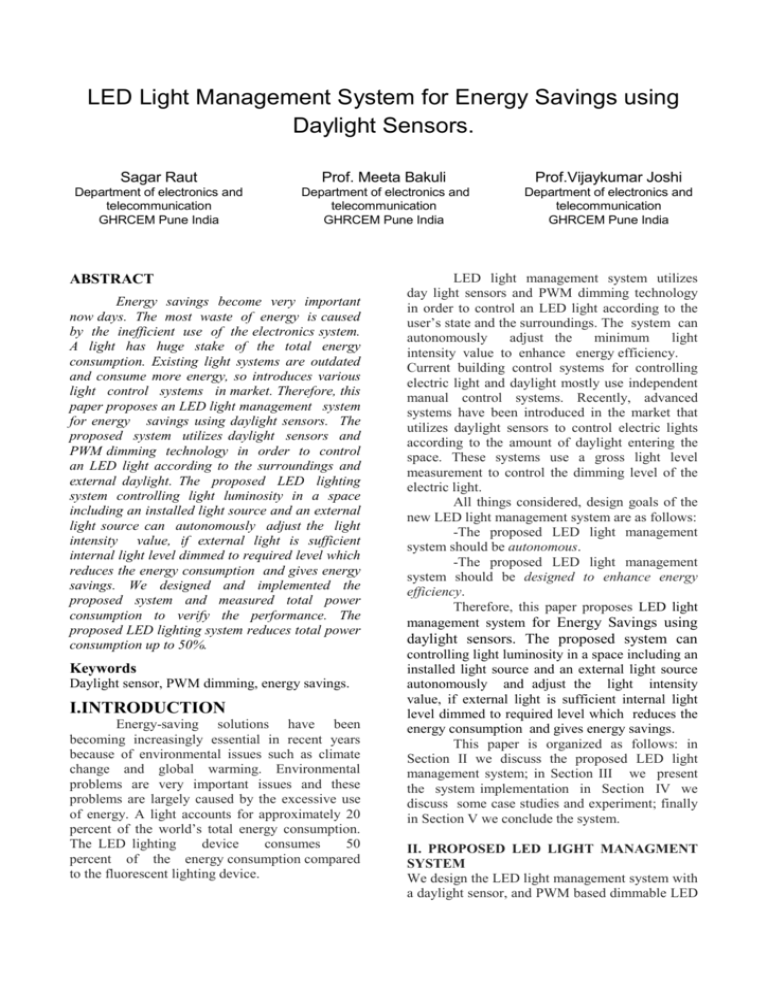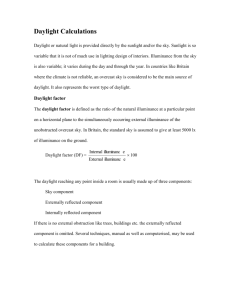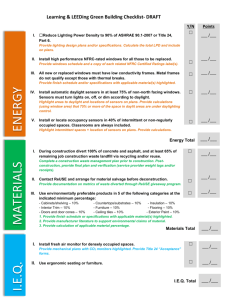i.introduction - Academic Science
advertisement

LED Light Management System for Energy Savings using Daylight Sensors. Sagar Raut Prof. Meeta Bakuli Prof.Vijaykumar Joshi Department of electronics and telecommunication GHRCEM Pune India Department of electronics and telecommunication GHRCEM Pune India Department of electronics and telecommunication GHRCEM Pune India ABSTRACT Energy savings become very important now days. The most waste of energy is caused by the inefficient use of the electronics system. A light has huge stake of the total energy consumption. Existing light systems are outdated and consume more energy, so introduces various light control systems in market. Therefore, this paper proposes an LED light management system for energy savings using daylight sensors. The proposed system utilizes daylight sensors and PWM dimming technology in order to control an LED light according to the surroundings and external daylight. The proposed LED lighting system controlling light luminosity in a space including an installed light source and an external light source can autonomously adjust the light intensity value, if external light is sufficient internal light level dimmed to required level which reduces the energy consumption and gives energy savings. We designed and implemented the proposed system and measured total power consumption to verify the performance. The proposed LED lighting system reduces total power consumption up to 50%. Keywords Daylight sensor, PWM dimming, energy savings. I.INTRODUCTION Energy-saving solutions have been becoming increasingly essential in recent years because of environmental issues such as climate change and global warming. Environmental problems are very important issues and these problems are largely caused by the excessive use of energy. A light accounts for approximately 20 percent of the world’s total energy consumption. The LED lighting device consumes 50 percent of the energy consumption compared to the fluorescent lighting device. LED light management system utilizes day light sensors and PWM dimming technology in order to control an LED light according to the user’s state and the surroundings. The system can autonomously adjust the minimum light intensity value to enhance energy efficiency. Current building control systems for controlling electric light and daylight mostly use independent manual control systems. Recently, advanced systems have been introduced in the market that utilizes daylight sensors to control electric lights according to the amount of daylight entering the space. These systems use a gross light level measurement to control the dimming level of the electric light. All things considered, design goals of the new LED light management system are as follows: -The proposed LED light management system should be autonomous. -The proposed LED light management system should be designed to enhance energy efficiency. Therefore, this paper proposes LED light management system for Energy Savings using daylight sensors. The proposed system can controlling light luminosity in a space including an installed light source and an external light source autonomously and adjust the light intensity value, if external light is sufficient internal light level dimmed to required level which reduces the energy consumption and gives energy savings. This paper is organized as follows: in Section II we discuss the proposed LED light management system; in Section III we present the system implementation in Section IV we discuss some case studies and experiment; finally in Section V we conclude the system. II. PROPOSED LED LIGHT MANAGMENT SYSTEM We design the LED light management system with a daylight sensor, and PWM based dimmable LED driver. Before presenting the proposed system with system architecture and important scheme, we discuss the problem of the lighting system. A. Problem statement The basic operating principles of the proposed system. L min Minimum light level; L max Maximum light level; TL-H Time for low light level to high light level; TH-L Time for high light level to low light level. C. Light Intensity Control Algorithm Fig. 4 illustrate a flowchart of a light intensity control algorithm that requires a signal of light lux level in space. The light lux level signal is received from daylight photo sensor. The proposed minimum light intensity control algorithm automatically adjusts Lmin based on the external light level in room. If external light is sufficient controller starts increase in dimming. If external light is low controller starts decrease in dimming Figure 1: Daylight/artificial light Interactive diagram The proposed system basically controls illumination intensity of a lighting device according to brightness of surroundings. That is, when the maximum value of illumination intensity of a lighting device is Lmax and the minimum value is Lmin, the illumination intensity becomes Lmax, if external light is sufficient and becomes Lmin, if external light is not sufficient. The system maintains internal light level according to external daylight. Sensor read and measures the surrounding light, and converts the amount of light to 1-10v electronic signal output. Figure 3: Flowchart of Light Intensity control Algorithm III. IMPLEMENTATION SYSTEM AND TEST B. Overview of system Figure 4: Implementation of proposed system Figure 2: Overview of proposed system The lamp light ON at full or dims to maintain the lux level, light output regulates according to the level of natural light. When nature light is sufficient, light dims to minimum but never switch off. Light level changed linearly with respect to external and internal light level. The proposed system consists of dimmable LED driver; microcontroller unit; daylight sensor assembly and LED module. Daylight sensor senses internal light level and gives voltage signal to microcontroller. Microcontroller does computation on received signal and controls the dimmable LED driver output current. If external light is sufficient microcontroller reduces the LED driver output current to 50% and maintains the space light lux level. The proposed system dimming works linearly, so get good energy reduction throughout day night cycle. Fig. 4 shows the prototype and hardware block diagram of the proposed system. The main processor part uses 8 bit microcontroller. This part plays a role in situation analysis, event processing, and learning. This part optimizes the control and state variables to adapt itself to the various environments. To provide energy saving services mentioned above, daylight photo sensor is needed basically. Sensor read and measures the surrounding light, and converts the amount of light to 1-10v electronic signal output. Additionally, there is a potentiometer for end users to set the brightness level, so that the daylight sensor can read, measure the available natural daylight against the target value, and calculate how much artificial light is needed. This demand is then converted in 1-10v signal, to be sent to the 110v dimmable LED drivers, who will then pump up the right amount of light out of the LED. LED driver part consists of current controller modules for driving LEDs. 1) Office and Institution building There is sufficient daylight available in a institutions and office building. In these places, Lmin is set according to the proposed light intensity control algorithm. 2) Trains There is sufficient daylight is available while train is running in day. The internal light can set to Lmin during daytime by using proposed light intensity control algorithm. B. Experiment and Results In an experiment, we measured total power consumption. Table 1 show the result of an experiment. The proposed lighting control system reduces energy consumption up to approximately 50%. Table1: Performance test results Output Data External Light Condition Load PWM dimming signal is driving the LED driver, which sets the output current value. By changing the duty cycle of PWM signal according to sensor output, can change the light lux level. Ouput Power [W] Dark Bright 22 LED's 22 LED's 26.27 11.39 Output Voltage [V] 71 65.47 Output Current [A] 0.37 0.174 Input data Input power [W] Loss in [W] Efficiency [%] 230Vac 30.14 13.92 3.87 2.528 87.16% 81.84% V. CONCLUSIONS AND FUTURE WORKS Figure 5: Floorplan of Test system Fig 5 shows a floorplan of test system. The light fallen on surface (internal artificial light +external light) is measured through lux meter. Lux meter is placed at 1.3 meter height. The LED driver used is 20W each with proposed system. IV. CASE STUDY AND EXPERIMENT A. Case Study Energy savings become very important now days. The most waste of energy is caused by the inefficient use of the electronics system. A light has huge stake of the total energy consumption. However, since there are no such low cost autonomous products considering both energy efficiency and user satisfaction, the existing systems cannot be successfully applied to institutions and corporate office buildings. Therefore, we propose paper proposes an LED light management system for energy savings using daylight sensors. The proposed system utilizes daylight sensors and PWM dimming technology in order to control an LED light according to the surroundings and external daylight. The proposed LED lighting system controlling light luminosity in a space including an installed light source and an external light source can autonomously adjust the light intensity value, if external light is sufficient internal light level dimmed to required level which reduces the energy consumption and gives energy savings. We designed and implemented the proposed system and measured total power consumption to verify the performance. The proposed LED lighting system reduces total power consumption up to 50%. REFERENCES [1] Jinsung Byun, Insung Hong, Byoungjoo Lee, and Sehyun Park “Intelligent Household LED Lighting System Considering Energy Efficiency and User Satisfaction,” IEEE Transactions on Consumer Electronics, Vol. 59, No. 1, February 2013 [2] Patent US 2014/0225512 A1 – “Electric light and daylight control system with a dual-mode light sensor,” Dagnachew Birru, Yorktown Heights,NY (US); Eduard Johannes Meijer,Eindhoven (N L).Aug.14 2014 [3]Patent US 7,111,952 B2 – “System to control daylight and artificial illumination and sun glare in a space,” Dragan Veskovic, Allentown, PA (US), September 26, 2006. [4] S. Matta and S. M. Mahmud, "An intelligent light control system for power saving," in Proceedings of the Annual Conference of the IEEE Industrial Electronics Society, pp. 33163321, 2010. [5] G. W. Denardin, C. H. Barriquello, R. A. Pinto, M. F. Silva, A. Campos, and R. N. do Prado, "An Intelligent System for Street Lighting Control and Measurement,” in Proceedings of the IEEE Industry Applications Society Annual Meeting, pp. 1-5, 2009.









